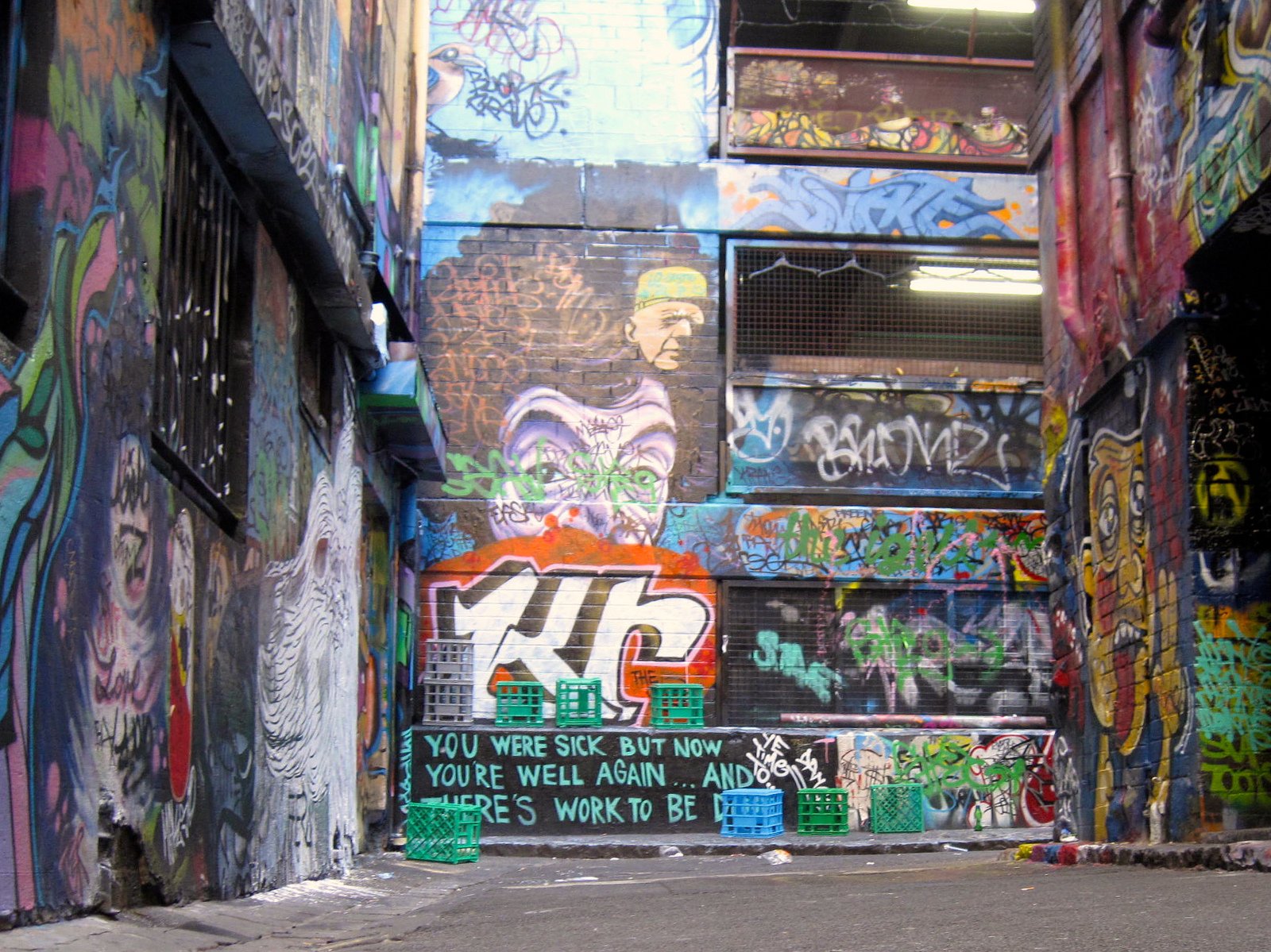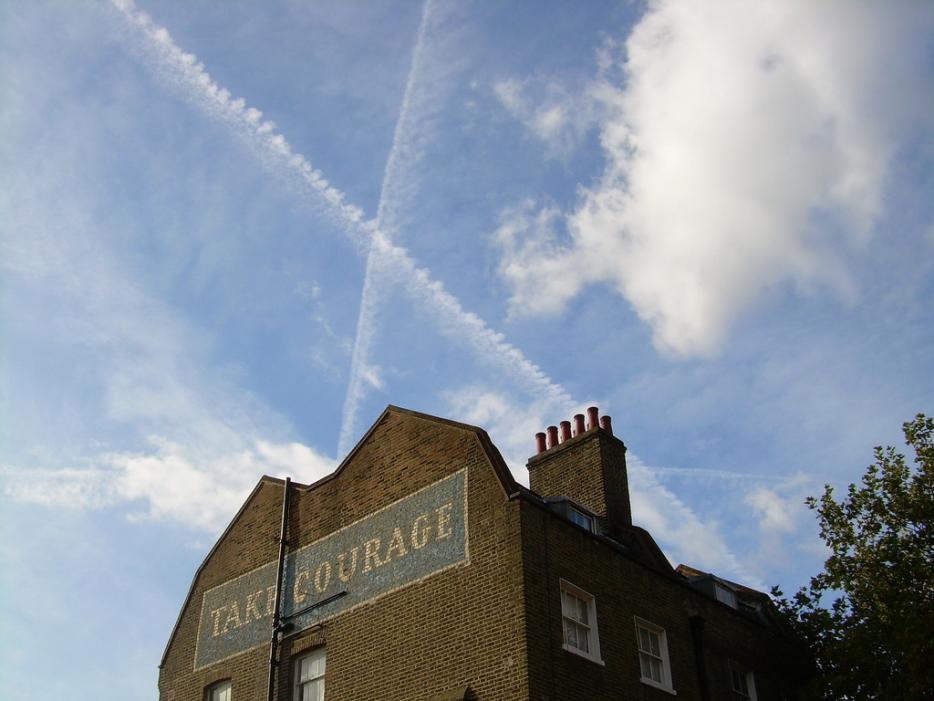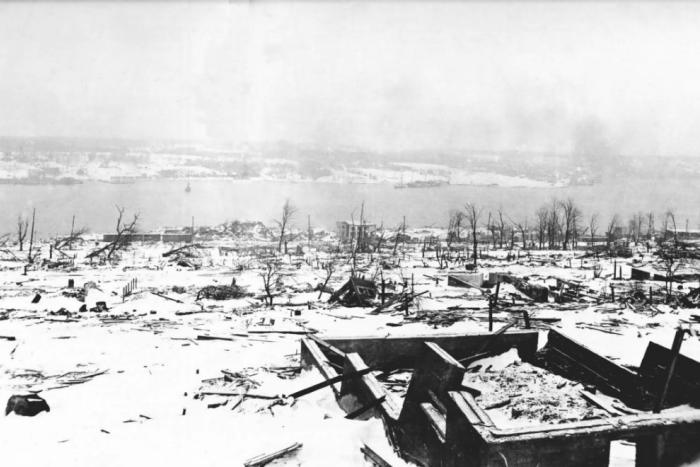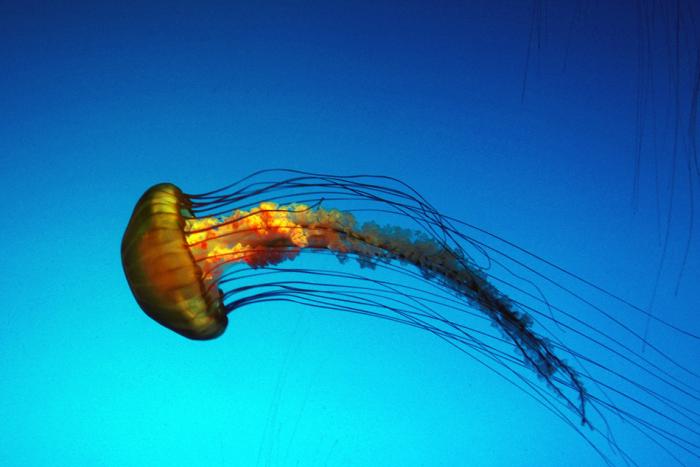You only get a few places in a lifetime that change you. The streets of London are crooked and lead you off course, but they come with 2,000 years of history. The Tube is hot and crowded, but it’s an Art Deco masterpiece. The people are tricky to get close to and it’s always nearly raining, but the changing weather is a constant bonding opportunity. London leaves you overwhelmed in a way that makes you wish, just sometimes, that the city would soften for a moment and tell you what it’s thinking.
If you’re looking for signs, you are lucky: the city is full of words. There’s a giant sign painted on the side of a building down by Borough Market, white block letters on blue: “Take Courage.” It’s loud and bold and impossible to miss, bound to speak to you when you first see it. For me that moment was in 2008, as I was about to go into the building across the street to interview for a job I really wanted. I saw the sign and took a deep breath, and they hired me.
“Take Courage” is a ghost sign—an old ad on a brick wall. Its original purpose had nothing to do with boosting the confidence of young professionals, but to get us to drink; it’s a promotion for the local Courage Brewery, founded in 1787. While you can still find Courage ales in the occasional London pub, the heyday is long past and people stumbling upon the sign on Redcross Way are more likely to reach for poetic interpretations. Had I first seen “Take Courage” on another day, I might have read something completely different into it, but for me it became a message about work. Every day, it reminded me to brace myself for a job that I ended up both loving and hating, but one that always spurred me on.
When you find signs in the cityscape, the city brings the words, but you bring the meaning. Sometimes they’re carved in stone; there’s a drinking fountain on the San Francisco Embarcadero that reads, “And they had nothing to restrain them from engaging in the most vicious practices.” Other times they’re on a poster, like the one I saw on the New York subway last spring that said, “A poem should happen to you like cold water or a kiss.” Sometimes they’re a work of art, like the neon sign in a café in London’s Holborn, proclaiming, “Love is the drug.” The words are there for anyone to read, but what they mean will be up to the viewer, and what’s going on in their world in the moment when they see it.
A ghost sign, however, is a specific thing. Found in major cities all over the Western world, these are the fading, crumbling advertisements painted straight onto a wall, usually around the early-to-mid century before the advent of the billboard. A strict definition declares the ad must be over fifty years old, promoting a product that’s no longer available (technically, by this definition, my “Take Courage” would not count), but there are grey zones. “Fading ad” or “brick ad” are also used, but “ghost sign” seems to have captured the imagination—it has a poetic quality that seems fitting. The ads for health tonics, ribbon mills, fountain pen repairs and other commercial staples lost to history are a poke in the ribs that everything is temporary. The peeling, sun-bleached paint of the signs is fading before our eyes, reminding us that time is passing, and that the city had a life long before any of us were here, and it will remain long after we—and the signs themselves—are gone.
*
Frank Jump has been documenting ghost signs in New York City and beyond for twenty years with his Fading Ads Campaign. These painted ads were never supposed to be permanent, Jump tells me over the phone from Brooklyn, and the best we can do is slow down the decay. Jump considers refreshing old ghost signs with new paint to be tantamount to ruining them.
There are no protections in place for ghost signs, meaning they live and die at the mercy of the elements—or more often, at the whims of the developers in control of the buildings they reside on. People often don’t notice these signs, says Jump. “But I think once you become aware of them, you become hyper-aware.” Jump sees them everywhere now. “You can rediscover an image, maybe after a rain, or during sunset when the light is hitting a building at a certain angle.” One of Jump’s favourite ghost signs is an old ad for Reckitt’s Blue—“the purest and best”—in Prospect Heights. The sign advertises laundry blue, a once-prized whitening agent that’s now pretty much obsolete. The ad is bright in colour because it was sandwiched between buildings for a long time. It was revealed when the neighbouring building was torn down. But the ad has since been concealed by a new building, possibly never to be seen again.
Asked if it makes him sad to lose ghost signs, Jump says he still looks for the fading ad for Bendix Home Laundry when idling in traffic towards the Williamsburg Bridge, before remembering it’s been sanded off. So yes, says Jump, it’s a loss. You become familiar with your city’s ghost signs: “They become part of your urban landscape. They become the mountain or the tree or the river, so when they disappear it’s like a mountain missing or a tree cut down.” But the impermanence of ghost signs is part of their charm, adds Jump—after all, they were never supposed to last forever.
Maybe this feeling is what the Portuguese call saudade: a melancholy or nostalgia for something we never even experienced. But with each ghost sign lost, there’s a new one emerging, says Jump—New York City is constantly being built, and structures are torn down to reveal old signs that were covered for decades.
*
“Ruins become the unconscious of a city, its memory, unknown, darkness, lost lands, and in this truly bring it to life,” Rebecca Solnit wrote in A Field Guide to Getting Lost. “A city is built to resemble a conscious mind, a network that can calculate, administrate, manufacture.” Another of my favourite ghost signs is in London’s Shoreditch, overlooking the Geffrye Museum garden. “Perfection,” it reads in elegant, fading letters—the original intent was to advertise Bloom’s Pianos but I walked past it daily for years and didn’t notice that part, it was just there as a nod to the things going right for me—a new house, a second date, the way London in August is grey and lush at the same time. My conscious mind was always calculating and manufacturing, taking the words I saw and putting them into an order that made sense to me.
Carl Jung called it “synchronicity,” or meaningful coincidence—that feeling of the right thing happening at just the right moment. As pattern-seeking animals, the urge to look for messages and connections in what we see can be hard to resist, and if you’re not careful this is how superstition starts. But while I’m irresistibly drawn to words and phrases that pop up unexpectedly, I don’t believe there’s anything magic about it. And at the same time, I think you can draw on the things you see to reframe whatever issue you’re pondering in that moment—a sort of self-made synchronicity. Like how I came across Kurt Vonnegut graffiti in a Melbourne alley not long after a season of panic attacks: “You were sick, but now you're well again, and there's work to do.” It felt like a promise that things can and will get better.
I don’t often tell people about my thing for finding words around the city, but I’ve realised a lot of people do this. I was in Amsterdam this summer, late one muggy night after lots of excellent wine, and I told someone I’d just met about my penchant for discovering phrases in the cityscape. Without saying a word, he took out his phone and showed me a photo of some graffiti: “I drifted between imagination and reality with you.” He took that photo in Thessaloniki years ago, he said, coming across the phrase on a wall, and felt it spoke perfectly to his relationship.

I know we only notice these things because we’re looking for them. It’s what linguistics professor Arnold Zwicky calls the “Frequency Illusion”—when something’s on your mind and you see it everywhere. But sometimes this hunger for signs becomes downright comical. This spring, when I was walking along the street in Richmond in London, I saw a ghost sign peeking out between the houses. I could only see half of it: “Choose you and the Temper,” it seemed to read. But after the whole thing was revealed the message became the complete opposite: “Choose your House and the Temperance.” The pragmatist in me would say it’s time to chill out—it’s an ad for paint! But the romantic would say it’s a sign that we decide our own fate.
*
Patrick Brill, the London-based artist known as Bob and Roberta Smith, says it’s no wonder discovering words can have this kind of effect. “Language is a kind of magic,” Brill tells me. “Exploring written language, almost like a painter would explore looking at something and try to paint it, is [an attempt at] getting to the root of ideas. It’s about how we look at things and see them as part of a feedback loop. It’s about how it feeds our imaginations.” Brill uses words extensively in his art. “It’s about trying to understand quite how we respond to things. Are we existing in a culture of language, or are we constructing that language?
While ghost signs are now a poetic addition to the cityscape, Brill points out that they were once purely commercial. Brill has made several brick ads around Hoxton in East London, for Ron’s Eels, Hoxton Electrovision and Dad’s hair salon. “People might see it as artwork but it has a utility. In one way, it’s a piece of public sculpture. In another way, it’s just an advertising sign,” says Brill. “I was trying to raise awareness of the real lives of people running these shops, and what they were experiencing.” Some of Brill’s brick ads are already headed towards ghost sign status as the shops close, adding an extra layer to the experience: small businesses in East London are under immense pressure from gentrification. And these signs become interesting as pieces of art when there’s a disconnect between what the sign is saying and what people are seeing—advertising products that no longer exist.
I always look out for Brill’s Ron’s Eels sign whenever I walk along that part of the Regent’s Canal. Signs become part of the fabric of the city, says Brill, who drew inspiration from the same Bloom’s Pianos sign I’d been passing for years.
Preservationists are constantly working to hold onto a city’s memories; English Heritage has been running the Blue Plaque scheme since 1866 to honour notable residents and events across London. But some of the quirkier stories are reserved for the inquisitive wanderers, says Rob Smith, a guide with Footprints of London who has an impressive knowledge of his Clerkenwell and Islington patch. Like the text splayed across a pub on Shepherdess Walk: “Up and down the City Road, In and out the Eagle, That’s the way the money goes, Pop! Goes the weasel.” That pub is in the spot of the original Eagle pleasure garden from the nursery rhyme, just off City Road, Smith tells me. “Weasel and stoat” is Cockney rhyming slang for coat, he adds: “So ‘popping the weasel’ would be giving your coat to a pawnbrokers and getting some money [to spend there].” Knowing this, the lullaby suddenly got a lot more sinister.
Smith’s favourite ghost sign is in Highgate, reading “Catering for Beanfeasts.” When Smith was growing, up a “beanfeast” was a soya instant meal—not exactly a tempting thought. “But when I looked into it, a beanfeast was actually an annual celebration where workers would go out into the countryside and enjoy a celebration meal,” says Smith. “[The sign] was a clue to discovery, and became a journey to a new story.”
In an old city like London, every fading sign holds at a story that places us in a bigger picture, reminding us that we really are just a very small part in two millennia worth of history. “I feel like we’re not only sharing the space geographically, but we’re sharing it in time with people who’ve gone before,” says Smith. “All these other people played their part in making it a city. When we find out about those other people, we think that maybe they’re not so different from us. Maybe in another 100 years’ time people will be wandering the streets wondering about us.”
My favourite sign of all isn’t actually a ghost sign—it’s the billboard in the Tenderloin in San Francisco that’s been changing quotes since the late 1950s, courtesy of the Kahn & Keville tire shop. Years before I saw it in person I first came across it on Tumblr, where it was brandishing a Cormac McCarthy quote that I’ve been thinking about several times a week for years: “Between the wish and the thing, the world lies waiting.” Like a beloved story you tell over and over, a randomly acquired phrase can run through a whole life.






